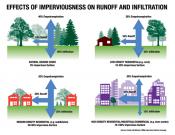Stormwater Facts
Protect and improve the City's surface water quality though polution prevention and watershed improvement.
Pollution
Non-point source pollution refers to pollution coming from different sources, which are usually everyday activities, and end up in our waterways. As stormwater runoff flows, it picks up sediment and chemicals from yards, driveways, parking lots, rooftops, and streets. These non-point source pollutants include:
Household Waste
Chemicals used in our homes that are not disposed of properly can be hazardous and become a threat to people and the environment. Some examples of Household Hazardous Wastes include:
- Bleach / Household Cleaners
- Paint / Paint Thinner
- Antifreeze / Car Oil
Pet Waste
Pet waste can contain bacteria and produce excess nutrients in local waters. Excessive nutrients will reduce the amount of dissolved oxygen in the water through algae growth. Algae use dissolved oxygen during decomposition and will alter the habitat, effecting fish and other aquatic life that require oxygen.
Stations with litter bags and a trash can are located in designate areas around the city. Picking up after pets can have a big impact on the amount of pollution in our waterways.
Litter
Debris and other litter are picked up by stormwater runoff and eventually lead to local streams. This debris, such as plastic bags, bottles, and six pack rings, does not only affect us, but also aquatic life.
Never throw trash down a storm drain or out of a car. Instead use appropriate trash or recycle bins.

